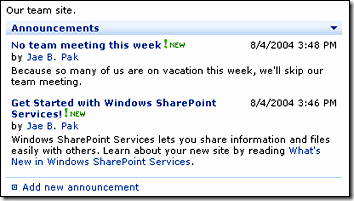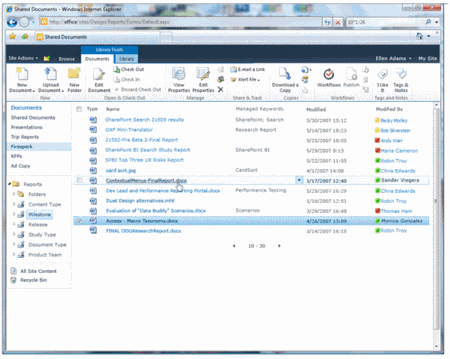SharePoint 2010 List View Blog Series: Part 1 – Introduction to the new List View

Hello. This is Greg Chan, a Program Manager on the SharePoint team. I am excited to kick-off a new blog series that will cover a wide spectrum of topics related to the new List View in SharePoint 2010.
What is a List View again?
Put simply, a List View is a view for displaying SharePoint list data. The concept of List View has been around since SharePoint v2. While there are other technologies being used for visualizing list data in different scenarios (e.g. Content Query Web Part), List View remains the default component for displaying list data in SharePoint 2010.
List Views can be spotted everywhere in SharePoint. They are used to display information such as your announcements, tasks and calendar schedules.
Examples of list views:

What’s the big change with List Views in 2010?
In 2010, we are introducing a component called the XSLT List View Web Part (XLV) that serves as the new default technology for displaying list data. This honor used to belong to the List View Web Part (LVWP), which was the default from SharePoint v2 to 2007. (Note: LVWPs are still supported in SharePoint 2010, but just not as widely used as the new XLV. )
The new XLV brings a ton of improvements to the SharePoint platform. This blog series aim to cover most of these areas.
What are the key benefits to the new List Views (XLV)?
Replacing the default technology for List Views required fundamental changes to the SharePoint platform. So why did we do it? Let me call out the high level benefits of the XLV:
- More Designer Friendly
- Rich customization support through SharePoint Designer while preserving browser UI experience
- Extensible and shareable custom styles
- Popular designer features such as Conditional Formatting.
- More Developer Friendly
- Uses standards-based XSLT instead of CAML
- Better documentation
- Easily extensible
- More End-User Friendly
- Enhanced user experience including Ribbon UI and new multi-selection model.
- Inline editing support
- More Robust Ways to Access Data
- Display enterprise data through Business Connectivity Services (BCS)
- Cross-web list views displaying data from another web
- Display list data joined from different lists
What’s coming up in the blog series?
Many people from different teams in the SharePoint family contributed to the new List View in SharePoint 2010. In this blog series, you’ll get a chance to hear from some of those area experts covering key List View topics.
Here are the topics that will be covered:
- Introduction to the new List View (you are reading it! :)
- List View – New User Experience
- List View Architecture
- List View Customization
- External Lists
- Conditional Formatting
- How to Share Your Custom List View Styles
- How to Create Custom Fields for the new List View
- Related Item View
- How to Create Views Displaying Cross-Web and Joined List Data
The order in which these topics will be published may change. We may also add or modify topics on this list. If there is any areas regarding List Views that you’d like to learn about and isn’t on this list, feel free to suggest them here.
Thanks for reading. I hope everyone is excited about the new List Views. Stayed tuned for more!
Greg Chan
Comments
Anonymous
November 16, 2009
The comment has been removedAnonymous
November 16, 2009
The comment has been removedAnonymous
November 16, 2009
I have a question about performance. From my SP2007 experience, it seems to me that rendering an XSLT view (Data View Web Part) takes longer than for a List View Web Part. Am I correct? How about SharePoint 2010?Anonymous
November 16, 2009
Please cover how the new list structure handles large lists (i.e. lists with more than 2,000 items). Thanks!Anonymous
November 16, 2009
Will all of these features be avaiable in SharePoint 2010 Foundation (WSS 4.0)?Anonymous
November 17, 2009
Good to hear this, eagerly waiting for other posts..Anonymous
November 17, 2009
Thanks Greg , It's really usefull.I hope, Customers like that.! Shake it :)Anonymous
November 17, 2009
Thank you Greg, great features!Anonymous
November 17, 2009
Waiting to learn more from you.. Please add more practical explanation with images.Anonymous
November 22, 2009
Please gives the second article.. could not wait for a long time :)..Anonymous
November 22, 2009
The comment has been removedAnonymous
November 24, 2009
How to add new Layout for PictureLibrarySlideshowWebPart in SharePoint 2010?Anonymous
November 28, 2009
Hi, Is the new XLV a merge between the previous Listview and Dataview WP ? are Dataview still available ?Anonymous
December 01, 2009
Hi Greg, This is great stuff. I'm really looking forward to the crosslist queries so that I can do rollups of tasks from sub-sites, for example. So I vote for this as your next post! In the meantime, can you point me to some documentation or provide just the key snippet to make this happen? I'd very much appreciate it!Anonymous
December 07, 2009
So it sounds like the XLV is a Data View (DFWP) web part that you can create in SharePoint Designer. So will there ever be a need to create a DFWP for a list or a library again?Anonymous
February 21, 2010
The comment has been removedAnonymous
March 03, 2010
The comment has been removedAnonymous
August 24, 2010
The comment has been removedAnonymous
January 11, 2011
What happened to the rest of the promised articles in this series? Where is the 'better documentation', i sure can't find it in the incomplete SPD Help filesAnonymous
January 31, 2011
Hey Greg, I implemented a solution in MOSS, where i used form view web part and list view web part converted into xslt which allowed me to apply multiple filters using XPATH as well and providing values to parameters using form view, but now with this how will i be able to achieve the same... Please let me know at ankursharepoint@hotmail.comAnonymous
January 31, 2011
Hey Greg, I implemented a solution in MOSS, where i used form view web part and list view web part converted into xslt which allowed me to apply multiple filters using XPATH as well and providing values to parameters using form view, but now with this how will i be able to achieve the same... Please let me know at ankursharepoint@hotmail.comAnonymous
August 28, 2011
Could you update this post with links to the subsequent articles - looks like exactly the guide I want to read... just not in love with searching for each article. :) Thanks!Anonymous
September 08, 2011
Hi! What about 'How to Share Your Custom List View Styles' post? Does he exist somewhere?Anonymous
September 18, 2011
Hi Greg! Any plans on doing the part of "How to Create Views Displaying Cross-Web and Joined List Data" ? Cheers, RobertAnonymous
September 28, 2011
Hi, How do you add different languages in same list in different rows? for ex. if a row is in english then can next row be in chinese?Anonymous
December 06, 2011
Hey Jeff Can you update thos blog post with the links to the other articles and was the article •How to Create Views Displaying Cross-Web and Joined List Data ever published?Anonymous
December 18, 2011
check this helpful link too... mindstick.com/.../64d0f6b6-1f1c-408d-84cd-52420c417475 Its also having a wonderful explanation on Create a list in SharePoint and Read list Data from SharePoint using C#. ThanksAnonymous
December 20, 2011
I have requirement. Where i need to create a site in SharePoint 2010 with i lack record or data. Can anyone guide me , for that any tools available or not..
